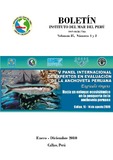Por favor, use este identificador para citar o enlazar este ítem:
https://hdl.handle.net/20.500.12958/1119Registro completo de metadatos
| Campo DC | Valor | Lengua/Idioma |
|---|---|---|
| dc.contributor.author | Espinoza Morriberón, Dante | |
| dc.contributor.author | Oliveros Ramos, Ricardo | |
| dc.contributor.author | Díaz Acuña, Erich | |
| dc.date.accessioned | 2012-11-16T12:57:57Z | |
| dc.date.available | 2012-11-16T12:57:57Z | |
| dc.date.issued | 2010-12 | |
| dc.identifier.issn | 0378-7699 | |
| dc.identifier.uri | https://hdl.handle.net/20.500.12958/1119 | |
| dc.description | Boletín IMARPE vol. 25 n° 1-2, 2010. p.81-84 | es_ES |
| dc.description.abstract | Se trabajó utilizando una metodología basada en Modelos Lineales Generalizados (MLG). La CPUE fue expresada en toneladas por duración de viaje. Las variables explicativas utilizadas fueron el año, mes, capacidad de bodega, latitud, inercia espacial y distancia a la costa. El modelo tuvo un coeficiente de determinación de 0,485, explicando casi la mitad de la variabilidad de la CPUE observada. La variable con mayor influencia en el modelo fue la capacidad de bodega (49% de la varianza explicada), debido posiblemente a que la flota anchovetera posee una capacidad elevada de captura y que los recursos pelágicos tienden a hiper-agregarse, incluso cuando están siendo fuertemente explotados. La correlación entre la CPUE estandarizada y biomasa estimada por un modelo de captura a la edad (r=0,74) indica que el método basado en MLG es recomendable para la estandarización de la CPUE. Se propone a esta CPUE como una alternativa para monitorear la biomasa de la anchoveta. | es_ES |
| dc.description.abstract | ABSTRACT: We used a methodology based on Generalized Linear Model(GLM). The CPUE was expressed as metric tons of catch per trip duration. The explicative variables used were year, month, holding capacity, latitude, spatial inertia and distance from the coast. The model had a determination coefficient of 0.485, explaining almost half of the variability observed in the CPUE. The variable with the highest influence was the holding capacity (49% of the explained variance), likely due to the high harvest capacity of the anchovy fleet and the hyper-aggregation of the pelagic resources, which occurs even if they are highly exploited. The correlation between the standardized CPUE and estimated biomass from a catch-at-age model (r=0.74) indicates that the method based on GLM is recommendable for the standardization of CPUE. The resultant CPUE is proposed as an alternative for monitoring the anchovy biomass | |
| dc.language.iso | spa | es_ES |
| dc.publisher | Instituto del Mar del Perú | es_ES |
| dc.relation.ispartofseries | Boletín IMARPE vol. 25 n° 1-2, 2010 | |
| dc.rights | info:eu-repo/semantics/openAccess | |
| dc.rights.uri | https://creativecommons.org/licenses/by/4.0/ | |
| dc.source | Instituto del Mar del Perú - IMARPE | |
| dc.source.uri | Repositorio Digital IMARPE | |
| dc.subject | Anchoveta | es_ES |
| dc.subject | Estandarización Del Cpu | es_ES |
| dc.title | Estandarización de la captura por unidad de esfuerzo (CPUE) de la flota industrial de cerco del stock norte-centro de la anchoveta peruana (Engraulis ringens Jenyns) | es_ES |
| dc.title.alternative | Standardization of the catch per unit effort (CPUE) of the industrial purse seine fleet extracting the north-center stock of the Peruvian anchovy (Engraulis ringens Jenyns) | es_ES |
| dc.type | info:eu-repo/semantics/article | es_ES |
| Aparece en las colecciones: | Boletín 25(1-2), 2010 | |
Ficheros en este ítem:
| Fichero | Descripción | Tamaño | Formato | |
|---|---|---|---|---|
| BOL 25(1-2)-11.pdf | 830,24 kB | Adobe PDF |  Visualizar/Abrir |
Este ítem está sujeto a una licencia Creative Commons Licencia Creative Commons

